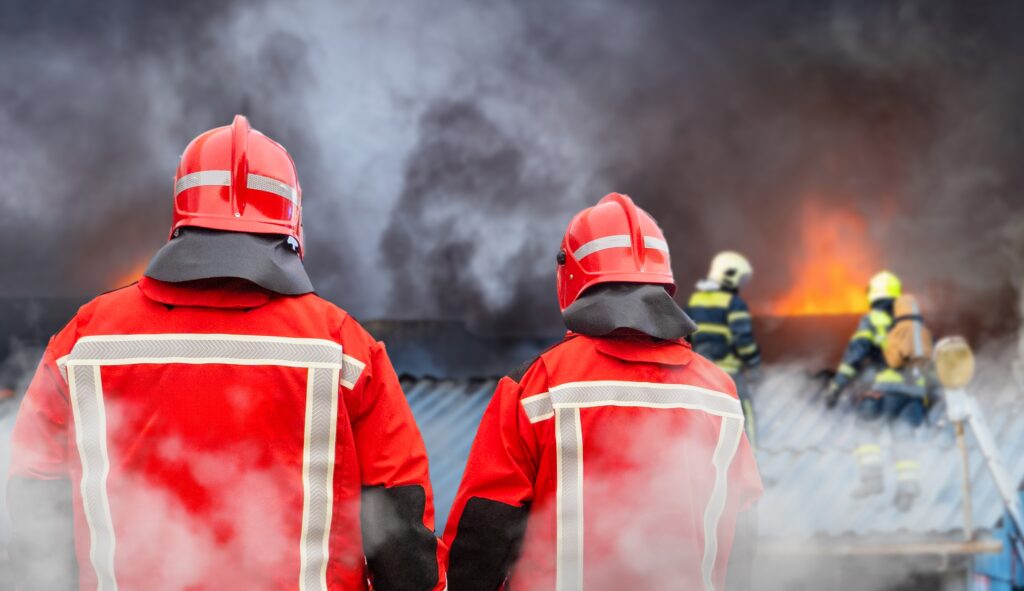
In recent years, air quality has become a growing concern across the country. Thick wildfire smoke blankets entire regions, and there is also the pollution from the burning of fossil fuels, and chemical exposures at industrial or fire scenes. With these, when the air turns hazy, so does our ability to breathe, think, and perform.
For most people, poor air quality means limiting outdoor activity or staying indoors. But for EMS workers, that’s rarely an option. EMS providers often operate in the middle of it, spending long hours outdoors, inside running vehicles, or at scenes filled with smoke or hazardous particulates.
These exposures don’t just make the job uncomfortable. Over time, these can threaten their health. Understanding air quality and how it impacts emergency responders is critical for protecting both provider safety and patient care.
When we talk about air quality, we are describing the amount of pollutants in the air, such as particulate matter, Ground-level ozone, Carbon monoxide, Sulfur dioxide, and Nitrogen dioxide.
Particulate matter with a diameter of 2.5 micrometers or less (PM2.5) is of particular concern. These particles can penetrate deep into the lungs and end up in our bloodstream. Natural events include wildfires, volcanic eruptions, and dust storms. Meanwhile, human sources include combustion of fossil fuels, industrial and agricultural activities, cooking, smoking, and even tire wear.
You are probably familiar with ozone being a good thing, protecting us from the sun’s radiation, but that refers to ozone high in the atmosphere. Ground-level ozone is actually bad for human health. It is generated when sunlight interacts with volatile organic compounds like gasoline or products of combustion like nitrogen dioxide, carbon monoxide, and methane.
The Environmental Protection Agency developed the Air Quality Index (AQI) as a way of giving the public access to daily air quality information and associated health risks. It is kind of like a thermometer, but with a range of 0 to 500, and shows 6 categories of health risk, color-coded green to red.
Short-term effects of poor air quality include coughing, wheezing, throat irritation, headaches, dizziness, and general fatigue, but can be life-threatening for certain groups with underlying pulmonary or cardiovascular conditions.
Long-term exposure to PM2.5 is deadly. It increases the risk of chronic diseases like asthma, COPD, heart disease, metabolic disorders, as well as cognitive and emotional disorders. This is because these tiny particles can travel to all organs of the body, even crossing the blood-brain barrier, resulting in oxidative stress, inflammation, and immune system activation.
For EMS workers, exposure to poor air quality is part of the job. Times when air quality is poor is also when EMS is most in demand due to increased calls for those affected. So staying inside is not an option.
Wildfires or brush fires, highway traffic crash responses, confined or poorly ventilated spaces, and extended standby assignments in unfavorable environments are all common sources of particulate exposure.
There are some steps you can take to limit your exposure. Check local AQI apps before shifts. When air quality is inferior, limit unnecessary outdoor activity between calls. Use an N95 mask or P100 respirator if operationally appropriate. Keep the ambulance doors closed when possible. Installing a portable HEPA filter in an ambulance has also been shown to significantly reduce particulate matter, with the added benefit of reducing airborne infectious agents.
References:
American Lung Association. (2016, January 2). How Wildfires Affect Our Health. Www.lung.org. https://www.lung.org/blog/how-wildfires-affect-health Accessed November 6, 2025.
American Lung Association Health Impact of Air pollution available at https://www.lung.org/research/sota/health-risks#:~:text=In%20adults%2C%20long%2Dterm%20particle,26 Accessed November 7, 2025.
Feng, S., Huang, F., Zhang, Y., Feng, Y., Zhang, Y., Cao, Y. and Wang, X., 2023. The pathophysiological and molecular mechanisms of atmospheric PM2.5 affecting cardiovascular health: A review. Ecotoxicology and Environmental Safety, 249, p.114444. Available at https://www.sciencedirect.com/science/article/pii/S0147651322012842 Accessed November 7, 2025.
Hahad, O., Rajagopalan, S., Lelieveld, J., Sørensen, M., Frenis, K., Daiber, A., Basner, M., Nieuwenhuijsen, M., Brook, R.D. and Münzel, T., 2022. Noise and air pollution as risk factors for hypertension: Part I—Epidemiology. Hypertension, 80(7), pp.1322–1339. Available at https://www.nesdis.noaa.gov/about/k-12-education/dust-ash-fire-smoke/how-air-quality-measured?utm_source=chatgpt.com Accessed November 6, 2025.
Hu, P., Li, Z., Hu, A., Gong, Y., Huang, X., Zhong, M., Li, X., Zhong, C., Liu, S., Hong, J., Zhang, W., Wang, Y. and Huang, Y., 2024. Are workers also vulnerable to the impact of ambient air pollution? Insight from a large-scale ventilatory exam. Science of the Total Environment, 947, p.174634. https://www.sciencedirect.com/science/article/abs/pii/S0048969724047831 accessed November 6, 2025.
NOAA website How is air quality measured available at https://www.nesdis.noaa.gov/about/k-12-education/dust-ash-fire-smoke/how-air-quality-measured?utm_source=chatgpt.com Accessed November 6, 2025.
Pena, M., Neu, D.T., Feng, H.A., Hammond, D.R., Mead, K.R., and Banerjee, R.K., 2025. Use of portable air cleaners within an ambulance workspace. Journal of Occupational and Environmental Hygiene, pp.1–14. https://pubmed.ncbi.nlm.nih.gov/40245411/ Abstract accessed November 7, 2025.
Wah, W., Gelaw, A., Glass, D.C., Sim, M.R., Hoy, R.F., Berecki-Gisolf, J., and Walker-Bone, K., 2025. Systematic review of impacts of occupational exposure to wildfire smoke on respiratory function, symptoms, measures, and diseases. International Journal of Hygiene and Environmental Health, 263, p.114463. Available at https://www.sciencedirect.com/science/article/pii/S1438463924001445, accessed November 6, 2025.
Zanaty, N., Mohamed, A.E., and Nabil, N., 2024. Respiratory health assessment of outdoor workers exposed to urban air pollution based on satellite observations. Remote Sensing Applications: Society and Environment, 36, p.101292. Available at https://www.sciencedirect.com/science/article/abs/pii/S2352938524001563 Accessed November 6, 2025.
Zundel, C. G., Ryan, P., Brokamp, C., Heeter, A., Huang, Y., Strawn, J. R., & Marusak, H. A. (2022a). Air pollution, depressive and anxiety disorders, and brain effects: A systematic review. NeuroToxicology, 93, 272–300. Available at https://www.sciencedirect.com/science/article/abs/pii/S0161813X22001668?via%3Dihub Accessed November 6, 2025.

